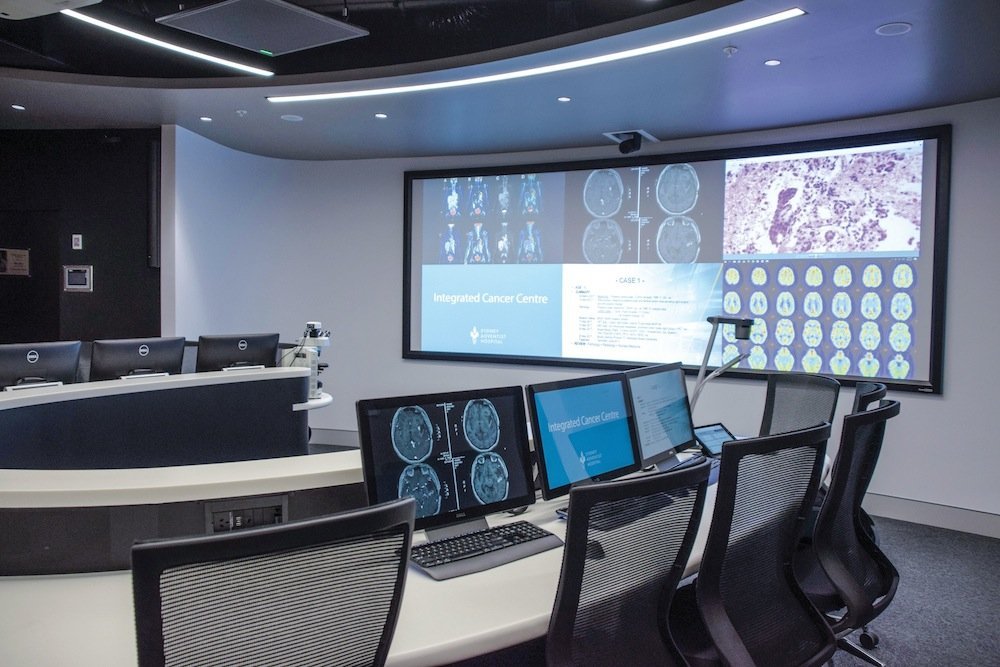News
5 Dec 2017
From boardroom to war room, AV technology joins the fight against cancer at Sydney Adventist Hospital

Subscribe to CX E-News
Sydney Adventist Hospital’s Integrated Cancer Centre conference room, dubbed the “cancer war room” is a purpose built facility where clinical multi-disciplinary teams (MDT) meet to discuss cancer patients’ cases. Each meeting is focused on a certain cancer or tumor stream and normally lasts an hour. Often an MDT meeting will work through some 20 cases in that time with clinicians both in the room or remotely via video-conference. It’s a punishing schedule where lives are at stake.
CRISIS TALKS
Formerly, MDT meetings were held in traditional boardroom-style rooms with a couple of screens at the front. There was a lot of messing around passing computer keyboards around, or trying (often vainly) to connect a device. If someone was late to the meeting, it’d disturb proceedings… everyone knew it was a less than satisfactory situation but no one had the time or the opportunity to think of a better way.
That was until the new Integrated Cancer Centre was being planned.
Barbara MacKenzie is head of IT operations (officially her title is: Manager, Information Services Operations and Infrastructure at Adventist HealthCare) and had a sense that because these MDT meetings followed an unusual format they needed special design attention.
Roneel Singh is an AV/IT consultant with WSP (officially his title is: Technical Director — Head of Technology Systems (ANZ) at WSP) and he was engaged to consider this knotty problem, after all, what we’re talking about isn’t a boardroom, or a video conference room or a teaching space, even if there are elements of all three. Barbara describes the breakthrough: “I think the lightbulb moment came when Roneel said: ‘you’re describing a crisis management centre’. That opened up our thinking conceptually and gave the architect a fresh sense of what the space could be.”
With the big initial breakthrough made, the hard work lay ahead: Barbara, Roneel and his team embarked on a consultation process that included the clinical leads from each specialty in order to intimately understand the running of an MDT meeting. As Barbara puts it: “We looked closely at the process the clinicians go through to work out how we could better provide technology to empower them. Our MDT room is the culmination of everything we’ve learnt.”
AV ANATOMY LESSON
There were some key learnings that provided a framework for the MDT room’s AV:
- Although there may be between 10 and 20 doctors and specialists contributing to most MDT meetings, the space needed to cater to up to 40 people — mostly observers, such as students, but also additional contributors in the instance of complex
- The space needed to be entirely ‘democratic’ — everyone around the table must feel they have an equal
- The MDT room needed to function as a VC space to enable clinicians to participate remotely.
- Multiple sources of content needed to be displayed simultaneously (and in a variety of configurations) on the big
- All the audio and video needed to be on the
Barbara MacKenzie: “My view has always been: if it’s not IP-based — if it’s not delivered across Ethernet — then it doesn’t belong. That’s a pretty challenging approach to take, especially a few years ago when we first mandated this.”
Roneel Singh: “Barbara’s always maintained she wanted an ‘enterprise solution’. She wanted to standardise and she doesn’t have an AV team or an IT team, she has one team that runs the whole facility.”
Set the challenge, Roneel immediately looked at an SVSI by AMX video-over-IP system.
Barbara MacKenzie: “I absolutely love the SVSI solution. “This is the first time we’ve used a product like this that’s distributed across the network. For example, our Simulation Learning Centre uses a card and frame-based video matrix solution, and it is so inflexible. Utilising a virtualised product instead of hardware-based appliances fits in well with our approach to technology. And SVSI is a mature solution.”
Roneel Singh: “The solution had to sit on the enterprise network and take full HD video with very low latency. SVSI had a product that was tested, proven and we’d used it on a number of other jobs in a similar application, so we were confident in recommending it to the client.
“It also meant we were able to do without a large frame-based solution and put the SVSI system into a compact communications room.
“What’s more, the expansion of the system is relatively easy — in effect, Barbara doesn’t need us back for that.”
NETWORKED AUDIO
A networked, and scalable video-over-IP solution needs an audio solution to match. There are plenty of Dante-based audio conferencing solutions on the market but Barbara and Roneel’s consultations suggested on-table gooseneck microphones (or similar) wouldn’t cut it.
Barbara MacKenzie: “I didn’t want a ‘mics on tables’ solution because it needed to feel more conversational. In my view, desktop mics foster a ‘one person on the mic at a time’ style of formality that wasn’t appropriate. When the Shure MXA910 ceiling array microphone popped up we were really keen to know more.”
Roneel Singh: “We’d normally advise against ceiling mics given the room has an open ceiling and the mic is share the ceiling space with the noise of large projectors — regular pendant ceiling mics would sound quite harsh in a space like this.
“But equally, we knew we needed a broad uniform coverage. Some of the clinicians are very softly spoken — you can’t hear them across the 4m diameter of the horseshoe seating — so sound reinforcement was essential.
The traditional approach of a series of mix minuses would have been quite cumbersome.”
Barbara MacKenzie: “Desk microphones also change behaviour. Some people lean right in close to talk into the mic. Some lean way back and mumble. The goal was to provide a more natural experience, where the technology is working for you even if you don’t notice it working for you. That’s my approach to the ideal user experience across the entire hospital.”
Roneel Singh: “With the Shure MXA ceiling mic array coupled with the JBL distributed loudspeaker system, participants can contribute in their normal speaking voice and they don’t even think they’re being amplified or recorded.”
JANDS SOLUTION
Roneel Singh: “It was beneficial that the products we required were all in the Jands house. This includes the Shure ceiling array microphone and the SVSI solution. From there the BSS Audio processing, JBL loudspeakers and Crown amplification being handled by Jands allowed us to get a whole solution from one distributor, which had distinct advantages. It meant we weren’t locked into products that were sub-standard but still made it easier for the contractor Fredon Technology to order and to have a single point of contact. And when you have a compressed time frame to complete a project, that sort of advantage can be very important.”
MORE AUDIO
The Shure MXA910 ceiling array microphone sits above the horseshoe seating with its lobes programmed to dynamically pick up those seated at the table and reject mechanical and ambient noise. An additional six Shure MX202 pendant ceiling microphones cover the ‘gallery’ section of the room. Audio from the microphones are fed via Dante to a network of BSS Soundweb London Digital Signal Processors including BLU-806 and BLU-103’s that take care of DSP and acoustic echo cancellation. On the output side, a JBL loudspeaker system ensures a natural sounding speaking environment. A combination of Control 52 and Control 62P loudspeakers cover the room, powered by JBL and Crown amplifiers.
POSITIVE PROGNOSIS
With innovation, comes a certain amount of consternation. No matter how much you consult, a new approach will throw up the unforeseen. So it was with a few butterflies in the stomach that Barbara and her team sat in on early MDT meetings, aware they had a limited window of opportunity to maximise the trust of the clinicians.
Barbara MacKenzie: “We attended every MDT meeting for a number of months. The first indication the facility was delivering as we’d planned came after an hour long meeting where 20 cases were being brought for review. The room was full of highly-scheduled specialists, some already in scrubs ready to go straight to theatre afterwards. – At least one said to me that at least 10 minutes were saved (because they were able to move instantly and seamlessly from one piece of digital information to the next), allowing each patient to be discussed without rushing.
An MDT meeting coordinator plays a pivotal role in the meetings’ efficiency. Using a runsheet listing patient cases and clinical information for review they sit at the control position orchestrating via a touch panel what is displayed. Clinical information, diagnostic imaging, pathology and clinically relevant photos/video is instantly toggled between the big-screen multiview configurations — at least 50-60 display source changes through the course of each meeting… all different clinical perspectives coming into play with no waiting. Because each of the contributors have their own computer, they can be set up, ready to go on cue. No one is waiting their turn for access or restricting anybody else who is contributing digital content.”
PUTTING HEADS TOGETHER
Increased efficiency is a big deal when time is of the essence. As Barbara puts it: “the whole process flows, and the flow of information has momentum”. But of equal importance — and the reason for so many highly paid, time-poor professionals to be convened in the first place — is the cross-pollination of ideas and information.
Barbara MacKenzie: “In one meeting a Pathologist when asked for his input on a particular patient’s case said “I’m interested to see the radiology imaging presented and hear what they have to say before I finalise my conclusion” In another instance PET and MRI scans are displayed side by side for review because comparing multiple content sources better informs the clinical decisions being made.”
“It doesn’t sound like much but rather than specialists submitting their comments about a patient in isolation, they’re actually waiting to hear what others have to say to better inform their own conclusion. So you’re really starting to see how the process is moving beyond the sum of the individual specialties.“
I would put it like this “Sydney Adventist Hospital’s Integrated Cancer Service is bringing clinical best practice and combining this with the best technology, elevating the entire process and achieving the best possible outcome for our cancer patients.”
GEAR LIST:
- Shure Microflex MXA910B Ceiling Array Microphone
- Shure Microflex MX202BPC Overhead Microphones
- AMX SVSI Video-over-IP System
- JBL Control Series Loudspeakers
- JBL CSA2120Z amplifier
- BSS Audio Soundweb BLU DSP
- Crown CT875 amplifier
Subscribe
Published monthly since 1991, our famous AV industry magazine is free for download or pay for print. Subscribers also receive CX News, our free weekly email with the latest industry news and jobs.




